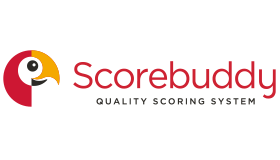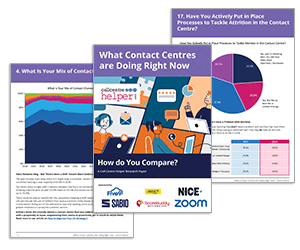This blog summarises the key points from a recent article from David McGeough at Scorebuddy, where he explores 13 essential outbound call centre metrics, exploring the impact they can have, and how you can improve them.
Call centres handle vast amounts of data daily, therefore racking outbound call centre metrics is essential for optimising efficiency and performance. These insights help businesses:
- Measure ROI
- Boost revenue
- Enhance agent productivity
- Improve customer interactions
Unlike inbound call centre KPIs, which prioritise customer service and response efficiency, outbound metrics focus more on revenue, sales, and lead generation, key drivers of business growth.
Key Outbound Call Centre Metrics and How to Improve Them
Understanding outbound call centre metrics is crucial for boosting performance and driving revenue. Below, we explore 13 essential metrics, what they are and actionable strategies to enhance them.
Conversion Rate
Conversion rate tracks the percentage of outbound calls leading to a successful outcome, such as a sale or appointment. It reflects the effectiveness of scripts, targeting, and agent performance. Industry benchmarks vary between 2% and 20% depending on the sector and lead quality.
Ways to Improve:
- Real-time quality monitoring
- Targeted coaching for agents
- Script adherence and optimisation
Revenue Per Dial
This metric measures the average revenue generated per outbound call. A strong figure indicates effective engagement and sales conversion, while a lower one may suggest weak targeting or ineffective scripts.
Ways to Improve:
- Refine lead segmentation
- Strengthen agent training
- Teach upselling and objection-handling techniques
Right Party Contact (RPC) Rate
Right party contact rate shows the percentage of outbound calls that reach the intended recipient. High rates signal efficient outreach, while low rates may point to outdated contact lists or ineffective dialling.
Ways to Improve:
- Use data validation tools
- Optimise call timing
- Warm up leads effectively
First Call Close Rate (FCCR)
First call close rate tracks how many outbound calls result in a commitment or sale on the first attempt. A high rate usually indicates strong lead quality and agent proficiency in handling objections.
Ways to Improve:
- Identify best sales techniques via QA
- Provide real-time coaching
- Ensure agents have accurate, updated information
Dial-to-Connect Ratio
A dial-to-connect ratio assesses the number of dials needed to reach a live person. A low ratio means fewer wasted calls, while a high ratio could indicate poor lead data or inefficient dialling strategies.
Ways to Improve:
- Provide accurate lead lists
- Train agents in best dialling practices
- Leverage AI for better prospect identification
Leads Generated
Leads generated tracks the number of qualified prospects gained from outbound efforts. High generated leads means better sales pipelines and ROI.
Ways to Improve:
- Audit call quality
- Refine scripts for better engagement
- Offer personalised coaching
Call Volume Per Agent
Call volume per agent measures how many outbound calls an agent makes within a given timeframe. The more calls made, the greater opportunities, however quality must remain a priority over greater outbound calls.
Ways to Improve:
- Use automatic diallers
- Implement AI for lead refinement
- Reduce idle time with QA insights
Average Handle Time (AHT)
Average Handling Time tracks the total duration of a call, including talk time and post-call tasks. While efficiency is important, calls that are too short may indicate rushed conversations. A low AHT can mean that your agents aren’t staying productive, however, if it drops to low, it could indicate rushed interactions.
Ways to Improve:
- Balance speed with call quality
- Refine training programs
- Optimise call scripts
Calls Per Hour Per Agent
Calls per hour per agent measures the number of calls an agent makes each hour, offering insights into efficiency. A low number may suggest inefficiencies in dialling or agent engagement.
Ways to Improve:
- Implement better call routing
- Set SMART goals for performance
- Enhance data quality
Occupancy Rate
Occupancy Rate is the percentage of time agents spend actively handling calls. A low rate suggests inefficiencies and to much downtime, while an excessively high rate, although looks good, may lead to burnout.
Ways to Improve:
- Adjust staffing levels
- Reduce after-call workload
- Use QA software to monitor adherence
Hit Rate
Hit Rate assesses how often outbound calls reach decision-makers. A strong hit rate means your dialling strategies and timing are aligning with your target audience, while a low rate may indicate poor data and poor lead quality.
Ways to Improve:
- Train agents to handle objections
- Improve lead data accuracy
- Refine call scheduling strategies
Lead Penetration Rate
Lead Penetration Rate shows the percentage of leads contacted within a set period of time. Low rates may mean that you have ineffective dialling strategies or agent workload issues. While a high rate means that you’re making the most of your list of leads.
Ways to Improve:
- Automate follow-ups
- Prioritise high-value leads
- Use real-time analytics for adjustments
Cost Per Acquisition (CPA)
Cost Per Acquisition measures the total cost of acquiring a new customer via outbound calls, including wages, software, and overhead. Lowering CPA can increase profitability and means more efficient spending.
Ways to Improve:
- Improve lead targeting
- Enhance agent training
- Utilise QA insights for process efficiency
Conclusion
Tracking outbound call centre metrics is just the beginning. Making sure you act on them is key. These insights help businesses refine training, remove bottlenecks, and drive efficiency.
Leveraging QA software helps automate reporting, highlight improvement areas, and enhance compliance so that you can spot potential opportunities for improvements and make the right moves, while ensuring stronger sales performance.
This blog post has been re-published by kind permission of Scorebuddy – View the Original Article
For more information about Scorebuddy - visit the Scorebuddy Website
Call Centre Helper is not responsible for the content of these guest blog posts. The opinions expressed in this article are those of the author, and do not necessarily reflect those of Call Centre Helper.
Author: Scorebuddy
Reviewed by: Rachael Trickey
Published On: 28th Feb 2025
Read more about - Guest Blogs, David McGeough, Scorebuddy






 Scorebuddy is quality assurance solution for scoring customer service calls, emails and web chat. It is a dedicated, stand-alone staff scoring system based in the cloud, requiring no integration.
Scorebuddy is quality assurance solution for scoring customer service calls, emails and web chat. It is a dedicated, stand-alone staff scoring system based in the cloud, requiring no integration. 









